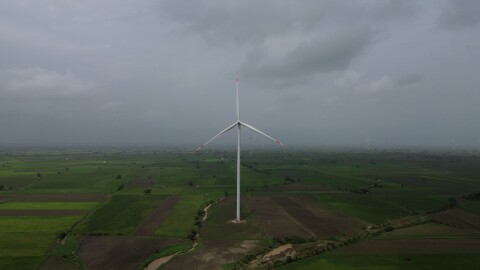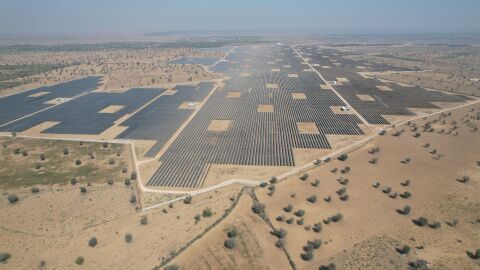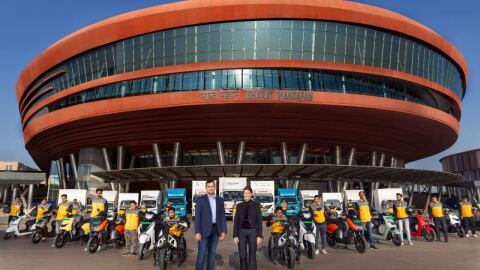Amazon aims to ensure that all its operations are eco-friendly. A big step in that direction is the commitment to induct 10,000 electric vehicles in its delivery fleet by 2025. That’s the word coming in from Abhinav Singh, Director, Fulfilment, Supply Chain and Transportation of Amazon India, who also highlights the importance of OEM partners such as Mahindra Electric, Tata Motors, Sun Mobility and Magenta Mobility in achieving Amazon’s sustainability goals. In a conversation with About Amazon India on World EV Day (September 9), Singh also weighs in on the battery swapping versus charging debate for EVs and offers solutions to reduce carbon intensity for the logistics sector at large. Edited excerpts.
1. What is Amazon's vision for EVs?
Delivering for our customers requires us to rely on various transportation solutions for long and short distances. Decarbonising our transportation network is crucial to meeting The Climate Pledge by 2040 and making 50% of shipments net-zero carbon by 2030, which is why we are actively transforming our fleet network and operations. We are transforming our transportation network by inventing new electrification solutions and using alternative delivery methods to stay the course on our commitments. The electrification of our fleet is a step forward in achieving a sustainable environment. It complements our ongoing efforts to build a supply chain that fosters energy efficiency and is environmentally responsible.
2. Amazon has committed to 10,000 electric vehicles in India by 2025. What's the progress so far?
We are well on our way to achieving this goal. We have partnered with upwards of 20 original equipment manufacturers (OEMs)—big and small—by experimenting with their vehicles from a form factor point of view We are working closely with small and medium enterprises that are rapidly inventing in this space in India. With large organisations like Mahindra Electric, TATA, and Sun Mobility, we have signed MOUs for a large percentage of their production to be inducted into the Amazon fleet here in India. Across our network in India, we have deployed the Sun Mobility battery swapping station in quite a few of our facilities. We have also signed an MoU with Sun Mobility for battery swapping stations. We experimented with battery swapping as a solution for 100-plus vehicles in the Delhi NCR region, and now we’re going to scale it across the country.
3. Partnerships are a strong pillar of Amazon's sustainability initiatives. Can you share some light on that regard?
Indeed, partnership remains cardinal in our quest to go net-zero. We have announced industry-first partnerships with Mahindra Electric, Tata Motors, Sun Mobility and Magenta Mobility to strengthen Amazon’s commitment to electric mobility. With their support, we are working with our Delivery Service Partners to induct a fleet of EVs and will introduce 10,000 electric delivery vehicles by 2025. We also enable EV deployment in our Delivery Service Partner fleet in multiple cities such as Bengaluru, New Delhi, Hyderabad, Ahmedabad, Bhopal, Indore and Lucknow.
We have been working with several Indian OEMs to build a fleet of vehicles that ensure sustainable and safe deliveries of customer orders and will continue to explore opportunities with OEMs to expand our fleet.
4. India is a large market. Do you see inducting electric vehicles for delivery as a challenge in non-metro areas, especially tier 3-4 markets?
The adoption of EVs has just started in India and the biggest challenge in the adoption has been the infrastructure to support it. We believe initiatives such as the Climate Fund and committing to go green will help address this challenge and fasten the adoption process.
5. How are you addressing the EV charging challenge? Also, what is your opinion on the battery swapping versus EV charging argument?
There are very few charging stations and hence currently battery swapping is preferred over charging for any long-distance journey. Battery swapping also reduces the cost of an EV by 30-50% and helps in boosting the adoption of an EV. It’s a journey that has just begun and with more investment-education-acknowledgement, the pace of adoption will increase.
6. World EV Day marks the celebration of e-mobility. What is your commitment towards sustainable mobility going forward?
Expanding our electric vehicle fleet to 10,000 vehicles by 2025 is a critical milestone in our journey to become a sustainability leader in the industry. We are committed to building a supply chain that will minimize the environmental impact of our operations. Over the last two years, we have created a holistic modus operandi of Intent-Action-Invest-Educate or Partner to institutionalise the process of reducing carbon intensity within our operations and other players in the transport and logistics ecosystem. I am sure this will encourage the ecommerce industry at-large to decarbonise last-mile logistics, a win-win for customers and society.











